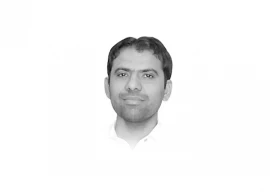
But in India, they have no such issues. In India all is well, as a week-long visit at the invitation of the Indian government made clear to us — a delegation of Pakistani journalists. Everybody we met, from the government, business and media, was on the same page. India is first and foremost about economic growth, we were told. Nurturing growth rates of eight to nine per cent, our hosts repeatedly underlined to us, means that India is not, cannot, and never will be interested in seeking instability in its own neighbourhood.
That much stands to reason. But like any emissary from troubled lands, my mind couldn’t help but look for the Achilles heel, the imprint of its own mortality, within the stellar growth rates that have transformed India and her interests in the region so profoundly over the past decade. And listening carefully to my Indian hosts, warm and hospitable and gracious all of them, I realised that what I was looking for was partially veiled, but in equal measure, right before our eyes.
What was right before our eyes was this: Nobody in India, it seems, wants to hear the bad news. There was a remarkable willingness on everybody’s part to whitewash everything under discussion. For instance, TV journalists told us that there is no Pakistan bashing in the Indian media, that media management always expects their news teams to be fair and balanced without recourse to sensationalism, that ratings do not trump fairness and accuracy. Indeed! The implementation of a value added tax has been a stellar success if you go by what we were told at the Federation of Indian Chambers of Commerce & and Industry. Right!
There is an overwhelming optimism in India that is a mirror image of the overwhelming pessimism in Pakistan. And just like we tend to wallow excessively in our pessimism, in India the bright prospects of their growing economy can often blind them to the weaknesses embedded within these growth rates.
Veiled from us were the problems that nobody wants to acknowledge. The Indian delegation to Davos, Switzerland, at the 2011 Word Economic Forum, has carried a message of ‘Inclusive India’ with them, but it’s unlikely that they will be reminding their hosts over there that around 40 per cent of India’s population lives at, or below, the poverty line. This means India has the world’s largest number of people living on less than two dollars a day. And since 2004, the number of people living below the UN mandated poverty line of $1.25 per day has increased by 100 million.
Think about that for a moment. To attain its goal of being a middle income country by 2025, India will need to lift more than 400 million people, one-third of the world’s total population of the poor, out of poverty. One-third! There are close to 40 districts in India where there is no writ of state and an entire province, the dreaded ‘K’ word, has to be bludgeoned into obedience on a daily basis. India’s growth rates might as well be unfolding in a foreign country for the majority of the country’s population, but it was very hard for me to find an Indian willing to talk about that with any measure of honesty.
India’s growth rates may be the toast of Davos for various reasons, their sustainability and resilience to external shocks for starters. But the shining avatars of ‘Incredible India’ would do well to remember that the epitaph for these growth rates has yet to be written, and for India to be truly ‘Incredible’, it will need to be truly inclusive, something that will take more than lip service to achieve.
Published in The Express Tribune, February 4th, 2011.



1727920472-0/Untitled-design-(40)1727920472-0-165x106.webp)









COMMENTS (58)
Comments are moderated and generally will be posted if they are on-topic and not abusive.
For more information, please see our Comments FAQ